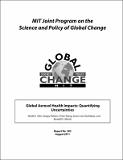| dc.contributor.author | Selin, Noelle E. | |
| dc.contributor.author | Paltsev, Sergey | |
| dc.contributor.author | Wang, Chien | |
| dc.contributor.author | Donkelaar, A. van | |
| dc.contributor.author | Martin, R.V. | |
| dc.date.accessioned | 2011-10-17T19:37:37Z | |
| dc.date.available | 2011-10-17T19:37:37Z | |
| dc.date.issued | 2011-08 | |
| dc.identifier.uri | http://globalchange.mit.edu/pubs/abstract.php?publication_id=2183 | |
| dc.identifier.uri | http://hdl.handle.net/1721.1/66304 | |
| dc.description | Abstract and PDF report are also available on the MIT Joint Program on the Science and Policy of Global Change website (http://globalchange.mit.edu/). | en_US |
| dc.description.abstract | Atmospheric fine particulate matter <2.5 μm (PM2.5) can cause cardiovasculatory and respiratory damages and mortalities. Assessing population exposure to and damages from PM2.5 is important for policy, but measurement networks are only available in a few regions. We assess variation resulting from using different sources of concentration information to constrain PM2.5 exposure worldwide, and compare the magnitude of this variation to uncertainties in epidemiological exposure-response functions and economic valuation of health impacts. We find that only 10% of global population is in areas constrained by ground-based data. We calculate and compare regionally-averaged population-weighted concentrations using two atmospheric models: the MIT/NCAR CAM3 aerosol-climate model, and the GEOS-Chem atmospheric chemistry model; and a satellite-derived PM2.5 product. We examine the contributions of different aerosol components to population-weighted PM2.5, and find large differences in exposure between U.S. and global populations. We use the MIT Emissions Prediction and Policy Analysis Health Effects model (EPPA-HE) to assess global health impacts and related economic costs, and conduct probabilistic uncertainty analysis of concentration-response functions. We use these combined approaches to project uncertainty ranges for health impacts and related economic costs from present-day PM2.5. We find large uncertainties in simulated PM2.5, especially globally; the magnitude of concentration variation among estimation methods is comparable to uncertainties in epidemiological functions and economic valuations. We identify major contributors to concentration variation, notably the parameterization of atmospheric dust. We estimate an annual global welfare cost of present-day (2000-2005) PM2.5 of $US 280 billion (range $120 – 510 billion), and related annual mortalities at 1.3 million per year (630,000 – 2.1 million). | en_US |
| dc.description.sponsorship | United States Environmental Protection Agency’s
Science to Achieve Results (STAR) program (RD-83427901-0) and the MIT Joint Program on the Science and Policy of Global Change, which is funded by a consortium of government, industry and foundation sponsors | en_US |
| dc.language.iso | en_US | en_US |
| dc.publisher | MIT Joint Program on the Science and Policy of Global Change | en_US |
| dc.relation.ispartofseries | ;Report no. 203 | |
| dc.rights | An error occurred on the license name. | en |
| dc.rights.uri | An error occurred getting the license - uri. | en |
| dc.title | Global Aerosol Health Impacts: Quantifying Uncertainties | en_US |
| dc.type | Technical Report | en_US |
| dc.identifier.citation | Report no. 203 | en_US |
